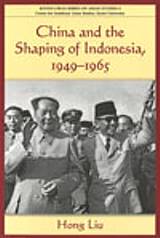ホーム > 書籍詳細ページ

Kyoto CSEAS Series on Asian Studies 4
China and Shaping of Indonesia, 1949-1965
238x153mm,並製・336頁
ISBN: 9784876983537
発行年月: 2011/11
- 本体: 2,300円(税込 2,530円)
-
在庫なし
日本国内からのご注文のみお受けします
中国とインドネシアの国際関係は,植民地統治を経たアジア政治の要であった.中国の発展はインドネシアの政治リーダーに近代化のもう一つのモデルとして用いられた.豊富な一次史料とインタビューを駆使してインドネシアの対中イメージ形成,および中国の外交戦略を分析し,中国外交がインドネシアの内政に与えた社会的影響を描出する.
"The Developing Economies" Vol.50 no.2, pp.204-206
Reviewed by Khoo Boo Teik
Reviewed by Khoo Boo Teik
Hong LIU is Professor of History and Asian Studies and the Chair of the School of Humanities and Social Sciences at Nanyang Technological University in Singapore. He was formerly Professor of East Asian Studies and the inaugural Director of the Centre for Chinese Studies at the University of Manchester.
Acknowledgements
List of Figures
Introduction: China in Indonesia: What’s in a Name?
Déjà Vu All Over Again? “The China Fever” and Its Significant Precedent
Approaches to China in Indonesia
Nature and Characteristics of China Observers in Indonesia
Structure of the Book
Part Ⅰ: (Re)presenting China
Chapter 1: Changing Images of China in Pre-1949 Indonesia
Historical Interactions and Perceptions of China in Pre-20th-century Indonesia
Indonesian Nationalists and China, 1900-49
Perceived Parallelisms
Conclusion
Chapter 2: Discourses on Chinese Politics
“New Democracy”: Chinese Practices and Indonesian Perceptions
China in the International Arena: “An Awakening Lion” or “A Threatening Red Dragon” ?
“Brother Mao”: Images of Mao Zedong in Indonesia
Conclusion
Chapter 3: Social Dynamism and Economic Progress
The Purposefulness and Orderliness of an Egalitarian Society
New China’s “Amazing” Economic Growth
The People’s Commune as an Epitome of Social and Economic Progress
Making Sense of China’s Socio-economic Progress: Politics or Chineseness?
Conclusion
Chapter 4: Of Culture, Religion and Intellectuals
“New Culture" and Nation-building
Intellectuals in the PRC: “Engineers of Human Souls” or “Tools of Propaganda” ?
A Question of Religious Freedom
Conclusion
Part Ⅱ: Constructing the China Metaphor
Chapter 5: Indonesian Dreams and the “Chinese Realities”: The Sociopolitical and Intellectual Dimensions
Political Instability and Cultural Antagonisms at Home
Disillusionment and Alienation of Intellectuals
Preconceptions about Indonesia and the Construction of China-images
Conclusion
Chapter 6: An “ Inner China" and External PRC: The Ethnic and Diplomatic Dimensions
Indonesian Chinese Society and the Cοnstruction of Images of the Ancestral Homeland
Brothers of different Kinds: Indonesians’ Paradoxical Views of the Chinese
Sino-Indonesian Diplomatic Relations and the Making of the China Metaphor
China Creates Its Own Images
Conclusion
Part Ⅲ: Shaping a New Trajectory
Chapter 7: Sukarno, the China Metaphor and Political Populism
Sukarno and China before1956
Mr Sukarno Goes to Beijing
Sukarno’s Perception of China and Vision for Indonesia
Conclusion
Chapter 8: Pramoedya, the China Metaphor and Cultural Radicalism
Pramoedya before 1956: The Evolution of a Cultural Intellectual
Pramoedya in China: The Politics of a Transnational Romance
The Transformation of Pramoedya: The Critical Years, 1956-59
Conclusion
Conclusion: China as an Alternative Modernity
Appendix: Biographical Notes on Major China Observers in Indonesia, 1949-65
Bibliography
Index
List of Figures
Introduction: China in Indonesia: What’s in a Name?
Déjà Vu All Over Again? “The China Fever” and Its Significant Precedent
Approaches to China in Indonesia
Nature and Characteristics of China Observers in Indonesia
Structure of the Book
Part Ⅰ: (Re)presenting China
Chapter 1: Changing Images of China in Pre-1949 Indonesia
Historical Interactions and Perceptions of China in Pre-20th-century Indonesia
Indonesian Nationalists and China, 1900-49
Perceived Parallelisms
Conclusion
Chapter 2: Discourses on Chinese Politics
“New Democracy”: Chinese Practices and Indonesian Perceptions
China in the International Arena: “An Awakening Lion” or “A Threatening Red Dragon” ?
“Brother Mao”: Images of Mao Zedong in Indonesia
Conclusion
Chapter 3: Social Dynamism and Economic Progress
The Purposefulness and Orderliness of an Egalitarian Society
New China’s “Amazing” Economic Growth
The People’s Commune as an Epitome of Social and Economic Progress
Making Sense of China’s Socio-economic Progress: Politics or Chineseness?
Conclusion
Chapter 4: Of Culture, Religion and Intellectuals
“New Culture" and Nation-building
Intellectuals in the PRC: “Engineers of Human Souls” or “Tools of Propaganda” ?
A Question of Religious Freedom
Conclusion
Part Ⅱ: Constructing the China Metaphor
Chapter 5: Indonesian Dreams and the “Chinese Realities”: The Sociopolitical and Intellectual Dimensions
Political Instability and Cultural Antagonisms at Home
Disillusionment and Alienation of Intellectuals
Preconceptions about Indonesia and the Construction of China-images
Conclusion
Chapter 6: An “ Inner China" and External PRC: The Ethnic and Diplomatic Dimensions
Indonesian Chinese Society and the Cοnstruction of Images of the Ancestral Homeland
Brothers of different Kinds: Indonesians’ Paradoxical Views of the Chinese
Sino-Indonesian Diplomatic Relations and the Making of the China Metaphor
China Creates Its Own Images
Conclusion
Part Ⅲ: Shaping a New Trajectory
Chapter 7: Sukarno, the China Metaphor and Political Populism
Sukarno and China before1956
Mr Sukarno Goes to Beijing
Sukarno’s Perception of China and Vision for Indonesia
Conclusion
Chapter 8: Pramoedya, the China Metaphor and Cultural Radicalism
Pramoedya before 1956: The Evolution of a Cultural Intellectual
Pramoedya in China: The Politics of a Transnational Romance
The Transformation of Pramoedya: The Critical Years, 1956-59
Conclusion
Conclusion: China as an Alternative Modernity
Appendix: Biographical Notes on Major China Observers in Indonesia, 1949-65
Bibliography
Index












